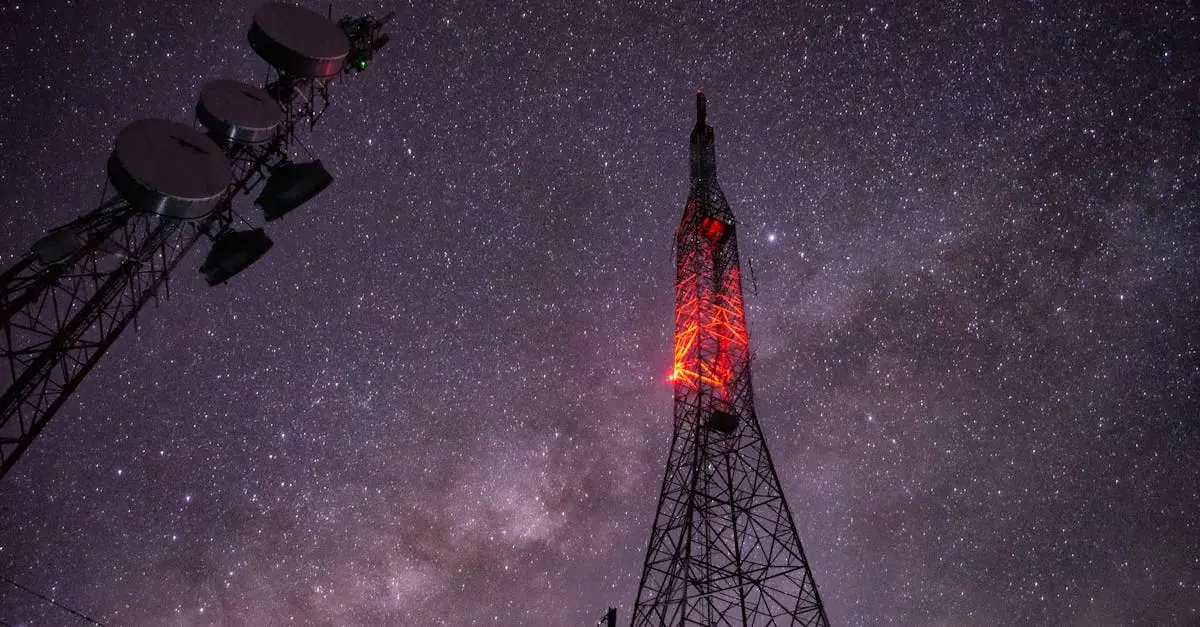Table of Contents
ToggleIn a world where staying connected is as crucial as breathing, remote sensing satellites are the unsung heroes soaring high above. These technological marvels are like the ultimate snoopers, capturing images and data from space to help us understand our planet better. They’re not just floating around aimlessly; they’re busy monitoring everything from climate change to urban sprawl, all while making Earth look like a high-resolution postcard.
Imagine having a bird’s-eye view of the world, spotting everything from deforestation to natural disasters. Remote sensing satellites make this possible, transforming complex data into actionable insights. So, next time you look up at the stars, remember that some of them are hard at work, helping us tackle global challenges and keeping us informed. Who knew space could be so helpful—and entertaining?
Overview of Remote Sensing Satellites
Remote sensing satellites serve essential functions in environmental monitoring and resource management. They launch into orbit to collect data about Earth’s surface and atmosphere, offering insights that ground-based observations can’t provide. Various sensors onboard capture images and detect electromagnetic radiation, transforming them into valuable information.
Data collected by these satellites supports disciplines like agriculture, forestry, and urban planning. Earth observation satellites typically monitor vegetation health, land-use changes, and weather patterns. Such information guides decision-making processes for governments and organizations.
Examples of remote sensing satellites include Landsat, Sentinel, and MODIS. Landsat satellites, operational since 1972, offer a historical perspective on land use and environmental change. Sentinel satellites, part of the European Space Agency’s Copernicus program, deliver timely data for disaster management and climate monitoring. MODIS, aboard NASA’s Terra and Aqua satellites, provides data on ocean temperature, land cover, and atmospheric conditions.
Applications of remote sensing technologies extend to disaster response and management. Satellites identify areas impacted by natural disasters such as wildfires, floods, and hurricanes. As a result, emergency services can formulate effective response strategies.
Remote sensing satellites contribute to sustainability efforts. Monitoring deforestation and agricultural practices helps develop strategies for conservation. Technologies continue to evolve, enhancing the accuracy and relevance of data provided by these satellites.
Innovations in remote sensing lead to improved spatial resolutions and data quality. New instruments, such as hyperspectral sensors, detect a broader range of wavelengths. With these advancements, understanding Earth’s complex systems becomes increasingly accessible.
Types of Remote Sensing Satellites
Remote sensing satellites fall into two main categories: active and passive. Each type serves specific purposes and operates using different methodologies.
Active Remote Sensing Satellites
Active remote sensing satellites emit their energy to scan the Earth and collect data. These satellites rely on instruments like radar or lidar to measure reflected signals. Radar systems, for instance, penetrate clouds and can gather information in any weather conditions. Examples include the European Space Agency’s Sentinel-1, which captures data for land and sea applications. The precise information from these satellites aids in urban planning, disaster management, and agricultural monitoring.
Passive Remote Sensing Satellites
Passive remote sensing satellites rely on natural energy sources, primarily sunlight, to capture images and data. These satellites detect reflected sunlight from Earth’s surface, enabling the observation of various features such as vegetation health or water bodies. An example is the Landsat satellite series, which provides critical long-term data on land use and environmental changes. Through analyzing the data, stakeholders can assess climate change impacts and enhance resource management efforts.
Applications of Remote Sensing Satellites
Remote sensing satellites serve multiple purposes across several fields, greatly enhancing our understanding and management of Earth’s resources. They enable efficient monitoring and assessment, leading to improved decision-making.
Environmental Monitoring
Environmental monitoring relies heavily on remote sensing satellite data. These satellites measure atmospheric conditions, track changes in land cover, and assess water quality. Regular data collection allows researchers to evaluate ecosystem health and detect issues like pollution or natural habitat loss. Insights from satellites facilitate the creation of effective environmental policies and conservation strategies.
Agricultural Assessment
Agricultural assessment uses remote sensing to improve crop management. Satellites capture detailed images of field conditions, allowing for the monitoring of crop health and soil moisture levels. Data gathered aids farmers in applying precision agriculture techniques, optimizing resource use and enhancing yields. By analyzing changes over time, stakeholders can identify trends and make informed decisions that benefit food security.
Urban Planning
Urban planning incorporates remote sensing technologies for better city development. Satellite imagery provides a comprehensive view of urban expansion, land use distribution, and infrastructure planning. Planners use this information to develop sustainable practices, manage resources efficiently, and enhance overall urban resilience. Continuous data feeds support real-time adjustments to accommodate population growth and environmental challenges.
Disaster Management
Disaster management greatly benefits from remote sensing capabilities. Satellites swiftly identify affected areas during emergencies, providing crucial information for response teams. Through detailed imaging, agencies assess damage and strategize recovery efforts effectively. Timely data allows for improved disaster preparedness, ensuring communities are better equipped to handle future events.
Future of Remote Sensing Satellites
Remote sensing satellites are at the forefront of innovation, shaping the future of environmental monitoring and data collection. Their evolving technologies and emerging trends hold significant promise for various applications.
Technological Advancements
Innovative sensors are enhancing the capabilities of remote sensing satellites. Hyperspectral imaging is gaining traction, providing detailed spectral information that aids in mineral exploration and environmental monitoring. Developments in miniaturization are allowing smaller, more agile satellites to be deployed, increasing accessibility for researchers and organizations. Cloud computing enhances data storage and processing, enabling real-time data analysis and faster decision-making. Solutions like artificial intelligence and machine learning are improving the accuracy of data interpretation, facilitating actionable insights from satellite imagery.
Emerging Trends
Sustainable practices are influencing the design and deployment of remote sensing satellites. Next-generation satellites embrace eco-friendly materials and energy-efficient technologies, reducing the carbon footprint associated with space missions. Increased collaboration between public and private sectors is fueling advancements in satellite technologies, promoting shared resources and expertise. Open data initiatives allow broader access to satellite data, empowering researchers, organizations, and the public to utilize valuable information. Growing interest in urban monitoring is leading to the development of dedicated satellites focused on urban expansion and infrastructure planning, improving livability and sustainability in cities.
Conclusion
Remote sensing satellites are indispensable tools for understanding and managing Earth’s complex systems. Their ability to provide critical data supports various fields from environmental monitoring to disaster response. As technology evolves, these satellites are becoming more sophisticated and accessible, enhancing the quality of insights they offer.
The integration of advanced technologies like artificial intelligence and hyperspectral imaging is set to revolutionize how data is collected and analyzed. This evolution not only aids in addressing immediate global challenges but also fosters sustainable practices for future generations. The ongoing advancements in remote sensing will continue to play a crucial role in shaping informed decision-making across multiple sectors.




